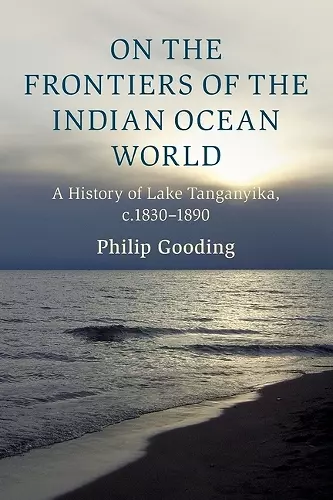On the Frontiers of the Indian Ocean World
A History of Lake Tanganyika, c.1830-1890
Format:Paperback
Publisher:Cambridge University Press
Published:17th Apr '25
£29.99
Supplier delay - available to order, but may take longer than usual.
This paperback is available in another edition too:
- Hardback£75.00(9781009100748)

The first history of Lake Tanganyika and of eastern Africa's relationship with the wider Indian Ocean World during the nineteenth century.
Philip Gooding analyses Lake Tanganyika as a crucial frontier zone of the wider Indian Ocean World during the nineteenth century. Using interdisciplinary sources and methods, he positions African peoples and environments as integral to the histories of global economies, religions, and cultures.This is the first interdisciplinary history of Lake Tanganyika and of eastern Africa's relationship with the wider Indian Ocean World during the nineteenth century. Philip Gooding deploys diverse source materials, including oral, climatological, anthropological, and archaeological sources, to ground interpretations of the better-known, European-authored archive in local epistemologies and understandings of the past. Gooding shows that Lake Tanganyika's shape, location, and distinctive lacustrine environment contributed to phenomena traditionally associated with the history of the wider Indian Ocean World being negotiated, contested, and re-imagined in particularly robust ways. He adds novel contributions to African and Indian Ocean histories of urbanism, the environment, spirituality, kinship, commerce, consumption, material culture, bondage, slavery, Islam, and capitalism. African peoples and environments are positioned as central to the histories of global economies, religions, and cultures.
'This book challenges our previous understanding of the 19th-century relations between the East African interior and the coast. Thanks to a truly original combination of sources and methodologies, Gooding's work discusses topics and perspectives that historians of East Africa and of the Indian Ocean could not ignore in the future.' Karin Pallaver, University of Bologna
'Gooding shows how East African frontier zones centred on Lake Tanganyika became integrated into the Indian Ocean world through the spread of Swahili and Arab influences, Islam, and the dynamics of the ivory trade. His second contribution is to write the first expansive history of this neglected yet important region.' Stephen J. Rockel, University of Toronto
'a much-needed contribution to African historiography … [it] offers groundbreaking contributions that bring together the often disconnected histories of the African interiors and the broader oceanic worlds; it also provides insights into the environmental and material-cultural processes that have animated the shared histories of Lake Tanganyika and the Indian Ocean world. … Its chapters can be read as standalone introductions, which is helpful for undergraduate- and graduate-level seminars on oceanic Africa's transregional, environmental, economic, and cultural histories.' Ahmed Yaqoub AlMaazmi, H-Net.org
'Gooding takes an innovative approach to what, in some hands, might have been limited to a regional East African study of this historiographically neglected zone by locating Lake Tanganyika as a frontier of the Indian Ocean World. … he recognizes the biases of his European sources and is meticulous in his reading of them. He is also careful in his use of oral sources.' Edward A. Alpers, Journal of Interdisciplinary History
'Gooding's book is an excellent work of interdisciplinary historical scholarship that rewrites the history of Lake Tanganyika by fusing inland East Africa to the maritime Indian Ocean World while centring lakeshore African actors in the nineteenth-century meeting of lake and littoral.' Ned Bertz, International Journal of Maritime History
'Doing truly 'interdisciplinary' history has been historically fraught. … Philip Gooding proves not only that this sort of history can be done but also that it is worth doing. In an incredibly organized and structured analysis, Gooding explores how the environment and peoples surrounding Lake Tanganyika shaped - and were shaped by - historical processes within the Indian Ocean World [… and] successfully repositions the East African lacustrine region as a historical 'frontier' of the broader Indian Ocean World, linking coast and interior in a clear and nuanced analysis.' Chelsea Davis, H-Net Review
'Gooding's book is a very original work, integrating a wide variety of sources, that could be adopted for use in an African history survey or seminar, an environmental history course, or a course on the Indian Ocean world.' Nathaniel Mathews, African Studies Review
'Gooding gifts us a book that serves the needs of IOW scholars from different disciplines, including those from economic, environmental, religious, historical, cultural and political backgrounds. The way that the author handles the different topics and also the varied types of sources make this as insightful a read for those deeply involved in IOW research as for those who are new to it.' Jacky Kosgei, African Studies Quarterly
ISBN: 9781009114189
Dimensions: 229mm x 152mm x 14mm
Weight: 389g
266 pages